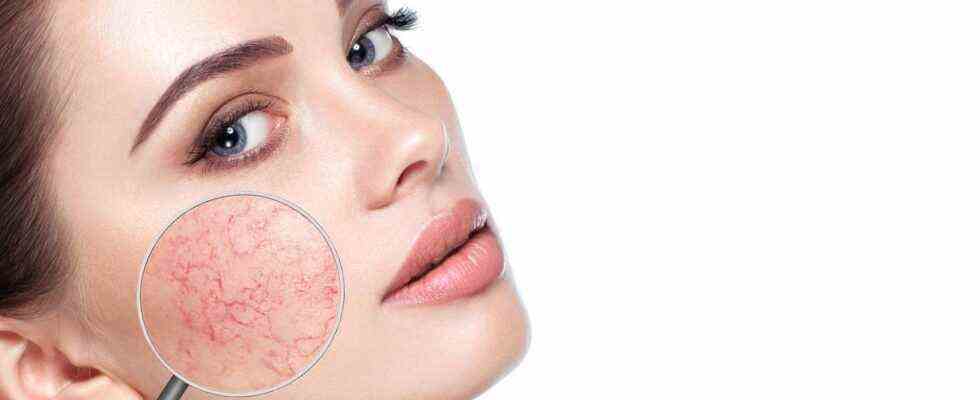couperose
Red veins on your face: where they come from and what you can do about them
Couperose is a vasodilatation of the subcutaneous tissue
© peakSTOCK / Getty Images
They shimmer through the skin in the cheek and nose area: Red veins are a purely cosmetic problem, but are associated with great suffering for many sufferers. How can this be changed?
From a medical point of view, there is no health problem if fine veins appear on your face. The correct term for these symptoms is couperose: This is a harmless enlargement of blood vessels (telangiectasia) that is hereditary. It occurs more frequently in women over the age of 30 and is considered an early form of rosacea – a chronic skin disease. There are three different stages, the first of which is manifested by red veins in the cheek and nose area, which become visible as the blood vessels under the skin widen. In addition, the affected area may be temporarily reddened. You can find out how to correctly interpret and treat the symptoms here.
Couperose: These are the first signs
The red veins on the face are usually only temporary at first, but can also be permanent. They bring unpleasant side effects, such as burning or itching, and often cause the skin to become drier and more sensitive. In the worst case, reddening of the skin can even occur, which persists due to blood congestion – but then one no longer speaks of couperose, but of rosacea: once the capillaries (small veins) in the cheek and nose area are permanently dilated, the skin looks constantly reddened . If you are already prone to weak connective tissue and, as a result, to spider veins or varicose veins, there is a very high probability that you will also get couperose. Unfortunately, this also applies to people with particularly light skin and blond or reddish hair – they tend to have red veins on their face more often than other types.
These factors promote couperose
As if it wasn’t bad enough that our genetic make-up can contribute to suffering from couperose – there are even more factors that can promote red veins on the face. The most common reasons for blood congestion or increased blood flow in the capillaries on the cheeks and nose are stress, high blood pressure, too much sun, excessive physical activity and a lot of sport or strong temperature fluctuations. In other words, if they often go to the sauna, for example. As a result, the blood vessels under the skin can dilate temporarily or permanently, the exact course cannot be predicted in anyone. The fact is, however, that you can alleviate the symptoms and counteract couperose.
How to treat couperose
The bad news is that if you’re already suffering from red veins on your face, there’s no way to completely fix them. But the good news is that you can treat couperose. And so that the Redness reduced – or at least concealed. In order not to irritate the skin even more, you should only use products that are fragrance-free and contain no preservatives. The same applies to essential oils, as they promote blood circulation in the skin and thus also couperose. It’s best to bet on one Couperose cream, which has a calming and anti-inflammatory effect due to its ingredients (including panthenol, niacinamide, coneflower, ergothionein or evening primrose oil).
Conversely, you should avoid greasy products that can clog your pores and irritate the skin. If you not only want to soothe and care for the red capillaries on your face, but also conceal them, you can green tinted concealer use – it counteracts the reddened skin as a complementary color and softens visible capillaries. If the couperose is already so advanced that no treatment methods noticeably work, you can think about a laser treatment. It reduces red veins on the face by up to 75 percent. However, this method also has its price.
Tip: If your face starts to glow, you can counteract acute couperose with these home remedies: put a damp washcloth on the affected areas or cool the skin with a gel containing eucalyptus and mint. Alternatively, you can also use a compress (e.g. made of black tea, horsetail, arnica and horse chestnut) to strengthen your connective tissue.
Red veins on the face: preventive measures
Since couperose is based on a hereditary predisposition, you can only partially prevent the red veins on the face. However, you can counteract vasodilatation by taking the following measures:
- Reduce consumption of alcohol, cigarettes and caffeine
- Avoid spicy or overly spicy foods
- Avoid excessive sunbathing and aggressive scrubs
Note: This article contains general information and cannot replace a visit to a doctor.
You might also be interested in:
This article contains so-called affiliate links. Further information are available here.


